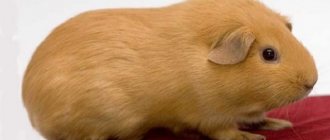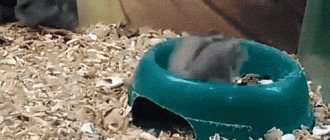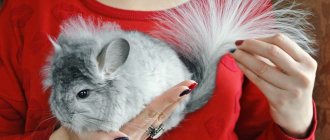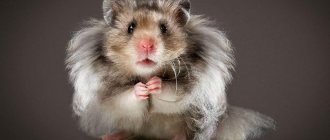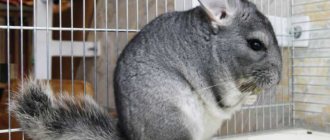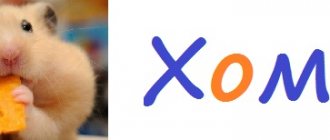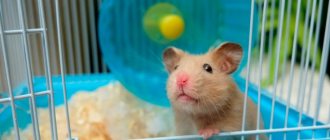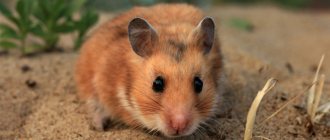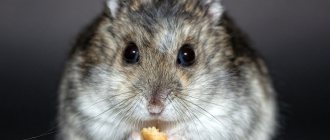The Djungarian hamster is ideal for those who, for one reason or another, do not have the opportunity to have a large pet. This type is one of the most popular. He is not whimsical, does not spread fur around the apartment and does not have the bad habits inherent in some pets. There are no problems with him. Ideal for those who do not have a large area or a lot of extra money. It is enough to select the smallest amount and the animal will delight your eye every day. Children love him very much and are interested in everything about Djungarian hamsters. You can accustom it to your hands and shoulder, after which the animal will be devoted to you every day. It’s just that at night a rustling sound can be heard from the cage; after all, this is a nocturnal animal.
What does a Djungarian hamster look like?
This species is also called dwarf. The Djungarian hamster grows up to 10 cm in length. Maximum weight is only 45 grams. The average life expectancy is 2–3 years, but there are long-livers. It picks up food with its paws in a very funny way, somewhat reminiscent of a person’s dinner. One of the most popular types of domestic rodents. Gets along well with children and is easily tamed. With proper care, he will never bite, except when playing.
By the way, in the first days after purchase it can be a little aggressive. But this behavior is only due to stress. Behave correctly with him at this time and after a short time he will easily allow himself to be tamed. Below you will see a photo gallery of small jungarians.
Let him out for a walk around the apartment once a week. You can only go outside with him if you have your own territory and you can catch him if something goes wrong. It is not advisable to stay under the sun for a long time; heat stroke is possible.
Djungarian hamster: photo gallery
Description of the animal
Appearance
Djungarian hamsters weigh only 45 grams, and their body length does not exceed 10 cm. The animals have a predominantly brownish-gray back color with a lighter tummy color. Today you can find babies with more unusual colors: gray-lilac with a white belly, cream, matte white.
A distinctive feature of Djungarian hamsters is the dark stripe on their back.
The rodent has a pointed muzzle and small ears. There is a tail, but it is almost invisible. The feet are covered with hairs.
Even if there is enough food in the cage, the dwarf will definitely make a supply, putting goodies on his chubby cheeks.
One of the owners said that for some reason the pet even put a metal nut that he found in the house behind his cheek and then for a long time could not lift his head off the floor, which alarmed the whole family.
Lifestyle
Djungarian hamsters are nocturnal animals. Their activity awakens with the onset of dusk. But during daylight hours, they will take a nap with great pleasure in a cozy house or on the owner’s lap.
It is better to place the cage in a quiet corner so that the animal can rest peacefully during the day. But at the same time, it is better to place it away from the bedroom so that night noise does not disturb people’s light sleep.
In the descriptions of the animals there is information that the babies are very active and nimble. Active rodents need to be held firmly to prevent them from falling.
Hamsters are animals that are very unstable to stressful circumstances. Frightened, falling or experiencing pain, the baby may show aggression and even bite. And he will lose trust in the person.
The agile animal loves to climb up and down. If his house has special equipment, he will happily tumble there, but he will also never miss the opportunity to explore a person, climbing on him like a tree.
Photo: https://pixabay.com/photos/hamster-rodent-cage-pet-muzzles-2724477/
The rodents perform all their tricks with such positivity and optimism that it’s simply impossible to watch them without smiling.
But it wasn’t just his cute face that helped the hamster gain popularity. The absence of an unpleasant odor and the baby’s cleanliness are the main advantages of this rodent.
How long does a dzhungarik live?
When getting a rodent, people often wonder: how long do jungarians live at home?
Having naturally good health, the kids will be able to delight their owners with their company for three years. Naturally, if they receive proper care, a balanced diet and the absence of stress.
What you need to know before purchasing
It is advisable to learn everything about Djungarian hamsters before purchasing. The life expectancy and health of your pet will depend on your care. How you treat him is how he will treat you.
- Immediately upon being brought home, the hamster must be placed in ready-made housing. When moving, the animal is guaranteed to be stressed, since everything it knew has disappeared. Once in a new place, for some time you will be afraid to even stick your nose out. The only thing that saves him is a house where he can hide and get away from the stress. At this time, he should not be disturbed; let him get used to the new environment. Only when the pet comes out on its own and explores its new place of residence, can you try to make contact with it.
- It is advisable to accustom hamsters to handling while they are small. This will become more and more difficult to do with age. Once the rodent has recovered from the stress, you can slowly make contact. How to train a hamster to be handled, read here: taming a hamster. You can play with him every day so that he gets used to human hands.
- There should only be one hamster in one cage. Dzungarians are loners and will not tolerate strangers on their territory. For those who want to have several rodents and place them in one cage, the Roborovsky hamster is more suitable.
Pair selection
For breeding, one hamster of different sexes is purchased. To get a large number of offspring, you will need 1 male and several females. To get healthy babies, adhere to the following recommendations:
- Djungarians should not be related; hamsters are purchased in different stores.
- Interspecific crossing is avoided. This applies to dwarfs and Campbell's hamsters. They belong to the dwarf breeds and often produce quite viable offspring. But when crossing there are risks for the female, for example, a large fruit. In addition, hybrids are not valued by breeders and cannot be presented at exhibitions. In this case, some diseases of hamsters of the same breed are often transmitted to their offspring.
- The weight of an adult hamster ready for mating is about 40 g. Both future parents must be absolutely healthy. When purchasing, pay attention to the coat - in healthy hamsters it is clean and shiny, the eyes are bright, do not water, and the tail is dry.
To prevent accidental crossbreeding, hamsters are carefully examined when purchasing. Under the guise of Djungarians, both Campbell and Sungur hamsters are often mistakenly sold. It is quite easy to confuse them, especially when the animals are of a standard color.
The color of the dzhungarik is distinguished by an extended black stripe on the back and a peculiar diamond shape on the head. The eyes are always black, unlike other breeds.
There are unusual coat colors:
- sapphire (closer to gray-blue);
- red (more like tangerine);
- white with gray (pearl).
The offspring of such hamsters are valued by breeders. But in this case, you need to clarify all the nuances of genetics in advance:
- You cannot cross two “tangerines”, otherwise they will pass on the so-called lethal gene to their offspring.
- The offspring of pearl-colored hamsters will not survive either.
But you can experiment by breeding representatives of rare colors among themselves. Sometimes the offspring is quite interesting.
Djungarian hamster cage
The small Djungarian hamster does not require much space. Mainly lives in a cage, aquarium or terrarium. Of course, the larger the area of the home, the better, but with proper design, a small area is enough for it.
The minimum cage size is 30 by 50 cm, but if it is larger, the fluffy will not refuse.
A hamster is very active in nature, so you need to provide him with this opportunity. To do this, use a running wheel, which every rodent should have.
He wants to taste everything. From time to time it is recommended to walk around the apartment. To prevent him from getting lost and chewing on anything, you can buy a walking ball for your hamster. In it, he will be able to walk freely around the apartment and the owner will always find him easily.
Keeping a Djungarian hamster includes cleaning. To do this less often, install a toilet and train your pet to use it. Then it will be enough to change the litter only in the toilet once a day, and clean the cage once a week.
If you plan to place your baby in an aquarium, then choose one with low walls. Otherwise there will be poor ventilation and high humidity. This situation will give a good start for the reproduction and development of bacteria.
Filling the cell
Since teeth grow throughout their lives, the pet must constantly grind them down. For these purposes, the pet store has special mineral stones. Those who cannot afford such a purchase can install a wooden block. If you don't put anything in place, you can see the hamster gnawing on the bars of the cage.
Each cage should have two feeders and a drinker. The first feeder is for dry food, which can stand for a long time; there should always be something there. The second is for products that quickly deteriorate; it must be empty. Make sure your pet eats everything and doesn’t leave it behind. If there is anything left, you need to pick up the remains before they start to spoil.
A drinking bowl is a mandatory attribute of each cell. Don’t listen when they tell you that juicy foods are enough for dzhungarika. This is not true, no matter how many there are, fresh water must be available.
You can make a house for a hamster yourself or buy it. Food will be stored there and your pet will sleep there.
Of course, there must be bedding in the cage. It serves for the comfort of the animal and absorption of odors. If a rodent relieves itself anywhere, the filler will immediately absorb everything. There is a very wide choice on the market, but we recommend using corn. It needs to be changed less often than others, and it absorbs smell and liquid better.
Features of keeping several individuals in one cage
It is better to keep pets separately. When two or more live in a cage, they can often conflict with each other. As a result, there will be injuries, sometimes this situation leads to death. Even with a positive attitude, the instinct to protect one's own territory remains. Therefore, over time, you will have to resettle or give one individual to someone. You can try to divide the home into two parts and fence them off, but the cage should be large enough so that there is enough space for both.
Eating dzhungarika
When the cage is equipped, the next thing that needs to be coordinated is the dzhungarik’s nutrition. We installed a drinking bowl and two feeders for this purpose.
The water in the drinking bowl needs to be changed every day so that it is always fresh. It is known that when you feel thirsty, the body’s performance already drops by 30%. When an animal is always thirsty, it will always feel tired. This can easily undermine your health.
Let's find out what Djungarian hamsters eat. Life expectancy largely depends on nutrition. The diet includes dry food, and fresh vegetables and fruits, nuts and seeds, cereals and herbs. But we must not forget that some foods are strictly prohibited:
- You should not include anything salty or sweet in your diet.
- Some vegetables including red cabbage, onions and garlic.
- Exotic and citrus fruits, kiwi, avocados, pineapples, etc.
- Pumpkin, melon, mushrooms, sorrel.
- It is harmful to feed a Djungarian hamster with food from your table if you do not know what can harm the animal.
Feeding your pet something from this list is a kind of lottery. There is a chance that nothing will happen, perhaps the pet will survive, but often everything ends in death or irreversible processes.
Imported food for hamsters is recommended, since it contains all the necessary vitamins. Russian food, although much cheaper, contains practically nothing good. It is necessary to properly organize the nutrition of the Djungarian hamster in order to extend its lifespan.
Instead of a summary of the diet. First of all, provide high-quality dry food. For dilution, give fresh vegetables and fruits without signs of rot, corn, peas, seeds, nuts, carrots, cucumbers, cabbage, dill, parsley, bananas, grapes, etc. If you doubt whether you can give a certain product, search with us on the website or ask in the comments.
Vegetables for dzhungarik
Everything needs to be taken in moderation; a product can be useful in limited quantities and harmful in excess. Let's give an example using potatoes. It contains many different essential microelements, for example: vitamin C, vitamins B1, B2, B6, vitamin P, K, carbohydrates with ash substances. Also, a rodent can grind their teeth on it, which makes this vegetable an excellent product. It contains fats and proteins that are so necessary for the animal.
But potatoes simply contain an excessive amount of starch, which is poorly digestible. It also contains the toxin solanine, which suppresses their immune system. Improper feeding can disrupt the metabolism and lead to the death of the animal.
Potatoes should be given gradually, monitoring the pet’s condition. The main thing is moderation, because if you give too much, you can get poisoned. You can increase the amount of potatoes in the diet to about 15-20%. Aging Djungarians need to be offered a boiled vegetable; they are not able to chew a raw one. Young people can put any, only in limited quantities.
Thus, potatoes for a pet give:
- Lots of vitamins, proteins, fats and carbohydrates;
- Ability to sharpen teeth;
- Improper metabolism;
- Possibility of poisoning;
- Decreased immunity;
- Dangerous diseases.
There are so many different factors, and they all just depend on the amount you eat.
Diseases of Djungarian hamsters
Diseases of Djungarian hamsters, there are quite a lot of them. We will not consider them all, as there is no point in doing so. Let's look only at those diseases that can be encountered with improper care.
- Fractures and dislocations most often occur. The cause can be both human actions and the pet itself. The pet is small in size and very nimble; it can break free from your hands and fall. Not feeling the height, the shoulder may fall. Often the cause of the disease is a poor-quality running wheel. The foot falls through and simply breaks at high speed. After this, you can see that the hamster has chewed off its own paw. This means that the limb could no longer be saved; there were no nerve endings left in it.
- Dental problems. As mentioned above, they grow throughout their lives. If you don't grind them down, they grow too big. Then the rodent can no longer eat and this becomes a serious problem. You can try to sharpen it yourself with a nail file, but it is better to consult a veterinarian. If a tooth is broken, a new one will quickly grow in its place.
- A cold with all that it entails. Djungarian hamsters are difficult to tolerate diseases. Make sure that the pet is not in a draft and that the room temperature is comfortable. Now you need to boost your immunity. To do this, include foods rich in vitamins in your diet.
- Parasites can affect anyone. Rodents are no exception; most often they suffer from ticks and fleas. Moreover, even a person can carry the larvae and infect a pet. Do not forget that he is practically a prisoner in a cage and has no opportunity to leave it.
- Too much fat in the diet can cause tumors.
- There are other diseases, you can read about them here: diseases of the Syrians.
As you can see, hamster diseases are mainly associated with humans. More precisely, they arise due to improper care.
Important Warnings
It is important to protect hamsters from stress. Animals are quite shy, so it is advisable to minimize their contact with any irritants: sharp sounds, smells, strangers and other pets.
Djungarians take care of their fur on their own, so dirty, crumpled or damp fur indicates health problems. Diseases are also indicated by any discharge in the eye or nose area. When they appear, you need to show the animal to a veterinarian.
Hamsters live on plains, so they often fall from horizontal surfaces. Because of this feature, it is not recommended to leave the animal on a table, chair or bed - a fall can lead to injury to the animal.
Pet breeding
During the year, this animal can reproduce 3-4 times. Each litter contains 4-9 children. They are born blind and bald, but within a week they are overgrown with fur. When they reach the age of one month, they need to be resettled. At this time, they gradually begin to be perceived by the mother as competitors. The female can become pregnant already in the fourth month of life.
The pregnancy of the dzhungarika lasts 19-21 days. Moreover, within a day after giving birth, the female is able to become pregnant again.
It is important not to disturb her in the last days of pregnancy and children under one week of age. You will leave your smell, and this will make your pet very panicky. If one day he smells someone else's scent on his offspring, he may simply kill his children. To prevent this from happening, limit contact as much as possible during pregnancy.
